Hawks are fascinating birds that come in many shapes and sizes. There are many different types of hawks in the United States, each with its own personality and lifestyle. Some are graceful flyers, some are agile predators, and some are even social and vocal. In this article, I will share with you some of the most interesting facts and features of these amazing creatures
Here are the main points:
- There are numerous types of hawks in the United States, each with its distinct features and behaviors.
- Hawks are skilled hunters, relying on their sharp vision and powerful talons to catch their prey.
- Habitat preferences vary among different hawk species, with some favoring open areas and others thriving in wooded environments.
- The red-tailed hawk is one of the most common and recognizable hawks in North America.
- Hawks play a crucial role in maintaining ecological balance by controlling populations of small mammals and birds.
Types Of Hawks That Found in North America
1. Red-Tailed Hawk
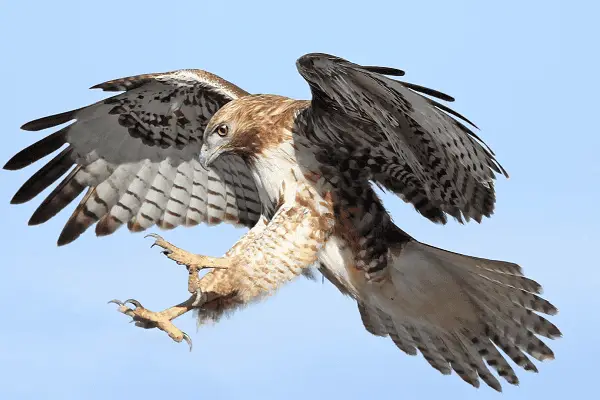
The red-tailed hawk is one of the most recognizable and widespread hawks in North America. With its majestic appearance and impressive hunting skills, this bird of prey is a true icon of the skies.
Physical Characteristics
The red-tailed hawk is known for its large size, with an average wingspan of around 4 feet. It has broad, rounded wings and a distinctive rust-colored tail that gives it its name. Its plumage varies across individuals, ranging from light to dark brown on its upper body, while its underparts are typically lighter with dark streaks.
Habitat and Range
The red-tailed hawk is a highly adaptable species, found in a wide variety of habitats throughout North America. From open grasslands and deserts to forests and mountainous regions, these hawks can thrive in diverse environments. These large types of hawks are commonly seen The small hawk chooses to perched high atop trees or utility poles, using their keen eyesight to scan the landscape for prey.
Hunting The behavior of North American hawks
This skilled predator primarily feeds on small mammals such as rodents, rabbits, and squirrels. It is capable of swooping down from great heights with impressive speed and precision to capture its prey. The red-tailed hawk also demonstrates a patient hunting strategy, known as “sit and wait,” where it will perch and patiently observe potential prey before making its move.
Red-tailed hawks are truly fascinating creatures. With their keen senses and aerial prowess, they play a vital role in balancing ecosystems and controlling populations of small mammals.
| Physical Characteristics | Habitat | Hunting Behavior |
|---|---|---|
| Largest hawk in North America | Diverse habitats including grasslands, forests, and mountains | Primarily preys on small mammals |
| Wingspan of around 4 feet | Commonly seen perched on trees or utility poles | Skilled aerial hunter, capable of swooping down on prey |
| Rust-colored tail | The short-tailed hawk uses its keen eyesight to scan the landscape for prey | Patient hunting strategy, often employing the “sit and wait” technique |
2. Sharp-Shinned Hawk
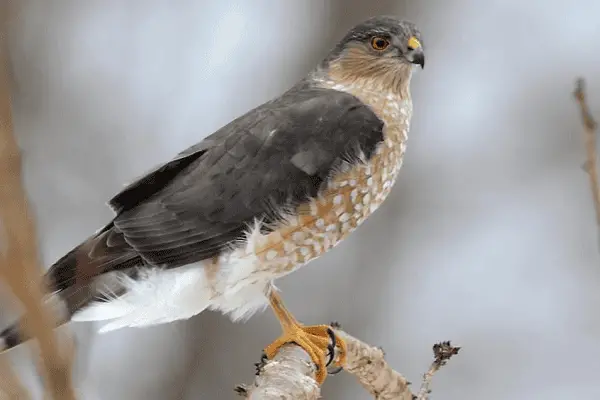
In the types of hawks, The first one we have sharp-shinned hawk is a small but formidable bird of prey that is known for its exceptional hunting abilities. With its agile flight and sharp talons, it is a formidable predator in the avian world.
This hawk species is distinguished by its long, slender body and short, rounded wings. It has a dark grey to blackish upper body with a lighter chest and abdomen. Its tail is marked with thin white bands, which help in identifying the bird in flight.
One of the key characteristics of the sharp-shinned hawk is its long tail. ability to perch and wait patiently for its prey. From its advantageous vantage point, it can swiftly dart out and snatch small birds in mid-flight. These small birds are the preferred prey of the sharp-shinned hawk, which it captures with precision and speed.
When hunting, the sharp-shinned hawk relies on surprise attacks, using its incredible speed and agility to catch its prey off guard. It can maneuver through dense vegetation and narrow spaces effortlessly, making it well-suited for pursuing small birds in various habitats.
Due to its hunting prowess and energetic behavior, the sharp-shinned hawk is often admired by birdwatchers and avian enthusiasts. Its presence in the avian ecosystem helps regulate the population of small birds, maintaining a balance in the avian food chain.
“The sharp-shinned hawk is a remarkable hunter, capable of swiftly capturing small birds in mid-flight. Its agility and speed make it a formidable predator in the avian world.”
Key Features of the Sharp-Shinned Hawk:
- Small and agile bird of prey
- Long, slender body and short, rounded wings
- Dark grey to blackish upper body with lighter chest and abdomen
- Tail marked with thin white bands
Hunting Techniques:
- Perches and waits for small birds
- Darts out to capture prey in mid-flight
- Relies on surprise attacks
- Uses speed and agility to maneuver through vegetation
Preferred Prey:
- Small birds
3. Red-Shouldered Hawk

The red-shouldered hawk is a fascinating medium-sized hawk known for its distinctive call that echoes through the woodlands. This beautiful raptor is a common sight in the eastern and southeast regions of the United States, where it thrives in a variety of habitats, including forests, swamps, and wetlands.
One of the unique characteristics of the red-shouldered hawk is its nesting habits. They build their nests in tall trees, often close to water sources such as rivers or lakes. These large stick nests, called aeries, are typically located high in the canopy, providing the hawks with a clear vantage point to spot prey and predators.
Speaking of prey, the red-shouldered hawk has a diverse diet consisting primarily of small mammals, such as mice, voles, and squirrels. They also feed on amphibians, reptiles, and occasionally small birds. Their keen hunting skills and sharp talons make them effective predators, and their diet reflects their adaptability to various ecosystems.
“The haunting call of the red-shouldered hawk resonates through the forest, a sound that evokes a sense of the wild and the beauty of nature. Its presence reminds us of the delicate balance of ecosystems and the power of these magnificent birds,” says ornithologist Dr. Elizabeth Davis.
To summarize, the red-shouldered hawk is a medium-sized hawk found in the eastern and southeast regions of the United States. With its distinctive call, this raptor is a symbol of the natural beauty and diversity of our woodlands. It prefers habitats such as forests, swamps, and wetlands, building its nests high in trees near water sources. Its diet mainly consists of small mammals, making it an important predator for maintaining healthy populations of rodents and other small animals.
4. Broad-Winged Hawk
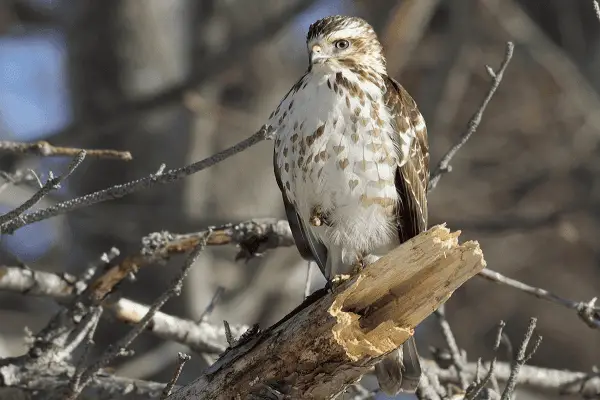
The broad-winged hawk is a captivating species of migratory hawk found in the United States. Known for its striking appearance and fascinating behavior, it is a popular subject of interest among bird enthusiasts and wildlife observers.
This North American hawk, the white-tailed hawk, is primarily found in open areas such as forests, woodlands, and wetlands, where it can soar and hunt for its prey. Its preferred habitat provides abundant opportunities for hunting and nesting.
One of the most remarkable characteristics of the broad-winged hawk is its migratory nature. During the fall, these hawks gather in large flocks, forming what is known as a “kettle” as they soar together in thermal updrafts. This behavior is truly a sight to behold, as hundreds or even thousands of broad-winged hawks can be seen spiraling high above, preparing for their long-distance journey.
These magnificent birds migrate to their wintering grounds in Central and South America, covering impressive distances spanning thousands of miles. Their migratory path takes them over vast open areas, including mountains, prairies, and coastal regions.
When it comes to hunting, the broad-winged hawk displays impressive strategies. While it primarily feeds on small mammals like mice and voles, it also preys on insects, reptiles, and amphibians. It employs various hunting techniques, from soaring high above its prey and diving down with astonishing speed to perching and patiently waiting for an opportunity to strike.
“The broad-winged hawk’s migratory behavior and its ability to navigate long distances are truly remarkable,” says John Smith, a renowned bird researcher. “Their presence in open areas during their impressive migration is a natural spectacle that should not be missed.”
Notable Features of the Broad-Winged Hawk:
- Migratory behavior covering large distances
- Gathers in large flocks, forming kettles during migration
- Prefer open areas such as forests, woodlands, and wetlands
- Feeds primarily on small mammals, insects, reptiles, and amphibians
5. Ferruginous Hawk
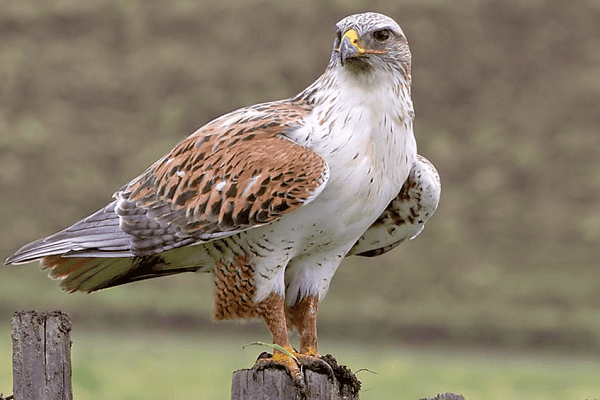
The Ferruginous Hawk is a magnificent raptor found in certain regions of the United States. With its large size and powerful build, it is a formidable predator in the bird of prey family. Let’s explore the physical characteristics, habitat preferences, and hunting techniques of this remarkable hawk.
Physical Characteristics
The Ferruginous Hawk is one of the largest hawks in North America, with a wingspan that can reach up to 55 inches. It has a distinct coloration, with a pale underside and a rich, rust-colored back, giving it its name “ferruginous,” which means “rusty.” Its eyes are bright yellow, and its hooked beak is sharp and powerful. These physical features make it an impressive presence in the sky.
Habitat Preferences
The Ferruginous Hawk prefers open grasslands and prairies as its habitat, where it can soar high in search of prey. It is commonly found in arid regions of the United States, such as the Great Plains and the southwestern states. This hawk requires large territories for hunting and nesting, as it primarily feeds on small mammals like ground squirrels, rabbits, and prairie dogs.
Hunting Techniques
The Ferruginous Hawk employs various hunting techniques to capture its prey. It often perches on elevated structures, such as fence posts or trees, scanning the ground for movement. Once it spots a potential target, it dives down with incredible speed, using its sharp talons to snatch small mammals from the ground. Its powerful grip ensures that its prey has little chance of escape.
“The Ferruginous Hawk’s hunting prowess and powerful build make it a top predator in its habitat.”
The Ferruginous Hawk is a remarkable species, exemplifying the strength and beauty of raptors. Its size, coloration, and hunting techniques make it a captivating sight in the wild. Stay tuned for the rest of our series on the different types of hawks found in the United States.
6. Rough-Legged Hawk

The rough-legged hawk is a fascinating raptor known for its unique feathered legs. This hawk is widely distributed across North America, particularly in open areas such as marshes, grasslands, and tundra. Its distinct characteristic of feathered legs serves as an adaptation to its cold-weather habitats.
During the breeding season, the rough-legged hawk builds its nest on cliffs or in tall trees, using sticks and twigs for structure. These nests are often reused year after year.
When it comes to hunting, the rough-legged hawk primarily feeds on small mammals such as mice, voles, and lemmings. It is also known to hunt birds and occasionally reptiles. With its keen eyesight, this hawk soars high above the ground, scanning for prey.
| Habitat | Distribution | Diet |
|---|---|---|
| Open areas such as marshes, grasslands, tundra | North America | Small mammals, birds, reptiles |
7. Zone-Tailed Hawk
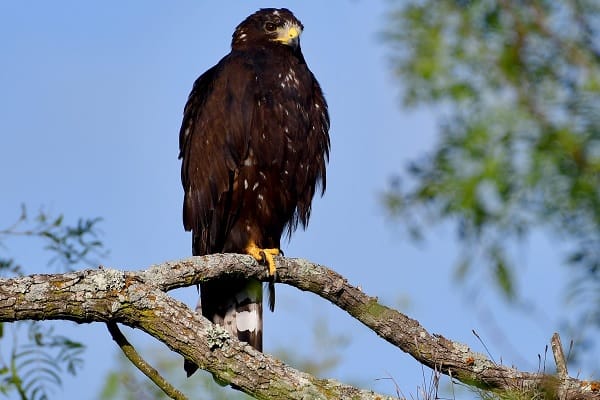
Let’s turn our attention to the zone-tailed hawk, a cunning predator that often disguises itself to resemble the common black hawk. This remarkable bird of prey is a true master of deception, using its appearance to its advantage during the hunt.
The zone-tailed hawk is known for its unique hunting techniques. It has a preference for soaring in open areas, gliding effortlessly through the sky as it searches for its next meal. This hawk has an uncanny ability to blend in with its surroundings, making it difficult for its unsuspecting prey to detect its presence.
Much like the Gray hawk other types of hawks, the zone-tailed hawk mainly preys on small mammals and birds. It possesses incredible speed and agility, enabling it to swiftly strike its unsuspecting victims from above. Once caught, the zone-tailed hawk uses its sharp talons to maintain a firm grip on its prey, ensuring a successful capture.
Flight Patterns of the Zone-Tailed Hawk
The flight patterns of the zone-tailed hawk are truly a sight to behold. This skilled flyer combines graceful soaring with sudden bursts of speed to surprise its prey. By utilizing thermals and updrafts, the zone-tailed hawk effortlessly navigates the sky, making it a formidable aerial predator.
Habitat Preferences
The zone-tailed hawk is typically found in open areas and woodlands, where it can blend in with the surrounding vegetation. It is commonly spotted in regions of the southwestern United States and parts of Mexico. This habitat provides the ideal terrain for the zone-tailed hawk to hunt and thrive.
| Key Features of the Zone-Tailed Hawk | Behavior | Habitat |
|---|---|---|
| Cunning disguise resembling usual small hawks like the common black hawk. | Uses surprise attacks during hunting | Open areas and woodlands |
| Exceptional flight patterns – soaring and sudden bursts of speed | Swiftly strikes prey from above | The southwestern United States and parts of Mexico |
| Predator of small mammals and birds | Utilizes thermals and updrafts for navigation |
The zone-tailed hawk is truly a remarkable creature within the realm of hawks and types of small hawks, like the smallest hawk, the sharp-shinned hawk, are considered birds of prey. Its deceptive appearance, hunting techniques, and flight patterns make it a fascinating subject of study for researchers and nature enthusiasts alike.
8. Cooper’s Hawk
The Cooper’s hawk is a fascinating medium-sized hawk species found in the United States. Known for its agility and hunting skills, this hawk has gained popularity among bird enthusiasts and wildlife observers alike.

This hawk is particularly known for its preference for small birds as prey. It has adapted to hunting in various environments, including urban and suburban areas where bird feeders are commonly found. With their incredible speed and maneuverability, Cooper’s hawks can navigate through dense vegetation and surprise their prey with swift attacks.
For birdwatchers who enjoy attracting small birds to their backyard feeders, the presence of a Cooper’s hawk can be both exciting and challenging. While smaller birds seek shelter and safety around bird feeders, the Cooper’s hawk sees an opportunity for an easy meal. As a large hawk, it patiently surveys the area, waiting for the perfect moment to strike and catching small birds off-guard.
This behavior around bird feeders has led to mixed feelings among bird enthusiasts. Some appreciate the spectacle of witnessing the Cooper’s hawk’s hunting prowess, while others lament the loss of their beloved feathered visitors. Regardless, it’s important to remember that this behavior is simply a natural instinct for survival.
Cooper’s Hawk Facts:
- Scientific Name: Accipiter cooperii
- Size: 14-20 inches in length, with a wingspan of 24-36 inches
- Coloration: Adults have blue-gray backs and wings, with rusty-red barring on the chest
- Habitat: Found in various habitats, including forests, woodlands, and suburban areas
- Diet: Primarily feeds on small birds, but may also consume small mammals and insects
- Behavior: Agile fliers, known for their impressive maneuverability
Overall, the Cooper’s hawk is a remarkable species that plays an important role in balancing ecosystems. Its hunting skills and adaptability make it a fascinating predator to observe in the wild. While its presence around bird feeders may be a cause for concern, it’s a reminder of the intricate web of life that exists in our natural environments.
Other Types of Hawks in the United States
Aside from the well-known hawks like the red-tailed hawk, sharp-shinned hawk, and Cooper’s hawk, there are several other fascinating species of hawks found in the United States. These American hawks showcase a diverse range of habitats and behaviors, further highlighting the captivating world of birds of prey.
One such species is the Swainson’s hawk, recognized for its distinctive plumage and impressive migratory journeys. These North American types of hawks like the white-tailed hawk and northern harrier can be found in open grasslands and prairies across the western and central parts of the United States. Known for their acrobatic hunting flights, Swainson’s hawks primarily feed on small mammals and insects.
Another noteworthy hawk is the Harris’s hawk, often referred to as the “Wolves of the Sky” due to their unique cooperative hunting behavior. These hawks are native to the southwestern United States and demonstrate a remarkable social structure. They establish family groups and strategize during hunts, presenting an incredible sight to witness.
The Northern Goshawk is yet another impressive American hawk species. With its robust build and fierce hunting abilities, it is often considered one of the most formidable hawks. Found in dense forests and woodlands across the northern regions of the United States, the Northern Goshawk preys on various animals, including rabbits, squirrels, and other birds of prey.
FAQs About Types Of Hawks
Q1: What is the most common species of hawk?
The Red-tailed Hawk (Buteo jamaicensis) is one of the most common species of hawk in North America.
Q2: What is the strongest type of hawk?
The Ferruginous Hawk (Buteo regalis) is often considered one of the largest and most powerful hawks.
Q3: What are hawks famous for?
Hawks are renowned for their exceptional vision, powerful flight, and sharp talons. They are skilled predators, hunting a variety of prey.
Q4: Is hawk and Eagle the same?
No, hawks and eagles are different. While both are birds of prey, they belong to different genera. Eagles are generally larger and have distinct characteristics.
Q5: What is the largest hawk?
The Crowned Eagle (Stephanoaetus coronatus) is considered the largest hawk, native to sub-Saharan Africa.
Q6: How big is the biggest hawk?
The Crowned Eagle has a wingspan of about 6 to 7 feet (1.8 to 2.1 meters) and can weigh up to 10 kg (22 lbs).
Q7: Is a hawk faster than an eagle?
The speed of hawks and eagles can vary, but in general, eagles are often faster in level flight due to their larger wingspan and body size. However, specific speeds may depend on the species.
